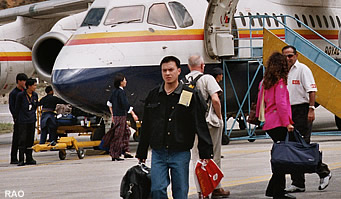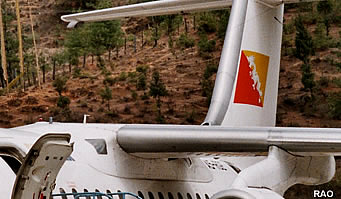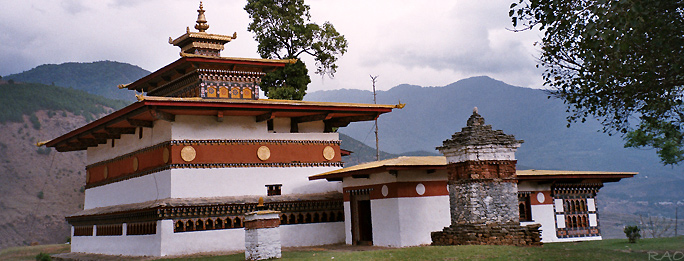 |
Bhutan's
Tourism |
|
|
|
 |
| Tourism
industry earns US $ 24 million in 2006 |
 |
 |
| Just
as the Department of Tourism had projected last year, the tourism industry
earned about US $ 24 million from 17,365 tourists that visited the country
in the past 12 months.
17,365
tourists visited the country in 2006. |
|
The
visitors came through 166 registered tour companies of the total 250 in
the country. Royalties paid by the industry to the government increased
from US $ 6.5 million in 2005 to US $ 8.3 million in 2006.
Like
in the past, the Bhutan Tourism Corporation Limited (BTCL) brought in the
maximum number of tourists, 2,63 9 in all. BTCL officials said that they
had projected to get only about 2,000 tourists in fall of 2006.
"This
has been a very fruitful year for us," said an official from BTCL. "We
look forward to as successful a year in 2007."
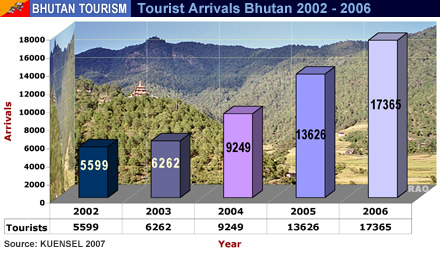 |
| Etho
Metho Tours and Treks saw about 1,721 tourist arrivals last year compared
with about 1,549 in 2005 followed by Yangphel Tours and Treks which brought
in over 1,012 tourists in 2006 compared with 891 in 2005.
Yangphel's
managing director Karma Lotey said that their business was more or less
stable with a 10 percent increase in the number of tourists they brought
in. |
|
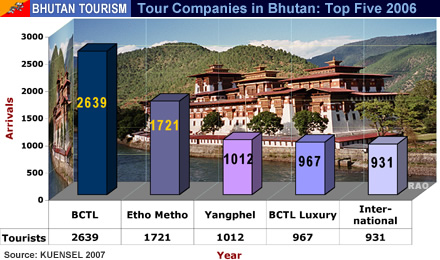 |
| The
BTCL Luxury Division comprising the Aman Kora and UMA together brought
in another 967 tourists.
Records
with the tourism department in Thimphu show that about 37 tour operators
brought in between 950 and 100 tourists in 2006. Between 100 and 50 tourists
visited the country through 16 tour operators, between 50 and 20 tourists
through 30 tour operators and 21 tour operators brought in between 20 and
10 tourists. |
|
The rest 58 tour operators saw between 10 and one individual
tourist visiting the country in the whole of 2006.
Month
wise records of tourist arrivals show a dropping trend in December, January
and February, which sees about 300 to more than 600 tourists and picking
up in March and April to more than 1,000 to 3,000 tourists.
The
number dwindles again between May and August to 200 and 900 tourists and
peaks between September till November, which sees between 2,000 and 3,000
tourists.
The
increase in the number of tourists, tourism officials said, was a global
phenomenon and in Bhutan, it could be clearly attributed to the kind of
promotion done over the past five years.
"We
have been in the international news for sometime and we were always reflected
in a positive light," said the director general of the tourism department,
Lhatu Wangchuk. "We have been declared as the number one tourist destination
in the world."
Tourists
from the USA still topped in terms of numbers followed by the UK and Japan.
The country continues to get "matured tourists" between 40-years and 70-years
of age.
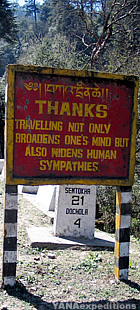 |
| The
director general said that tourists from European countries was also increasing
and so were tourists from China, Taiwan, Hong Kong and Thailand.
Although
trekking is improving, Lhatu Wangchuk said that culture tourism still remains
the main product in tourism in the country.
He
said that as the tourism department develops more trek routes and encourages
community tourism like the Nabji and Korphu trail, they expect to have
more tourists into trekking.
"We
operated about 15 groups on that trail in one season in 2006, which is
quite a good number to begin with," said Lhatu Wangchuk. "The package is
still continuing since it is a winter activity, between October and March."
He
also that the department was developing winter packages for tourists, in
places like Trashigang, Mongar, Trongsa and Zhemgang. |
|
Considering
that the tariff on tourists visiting the country has not been revised for
the last 15-years or so, Lhatu Wangchuk said that they were looking into
possibilities of raising the tariff by 20 or 25 percent a day for each
tourist.
"We
have to ask the tour operators to sell their packages at higher price but
provide quality services and facilities like better transportation, food,
guide services and standard accommodation," he said.
He
said that having spent the last four years focussing on policy issues,
strategy and tourism act, the department would now shift its focus on raising
hotel standards and creating better infrastructure.
"The
minimum standard for hotels in the country should be three star for Bhutan
to do well," Lhatu Wangchuk said. "We will not accept anything lower than
that."
The
Zhiwaling resort in Paro, which recently started operation saw 24 percent
occupancy with inquiries and reservations still coming in.
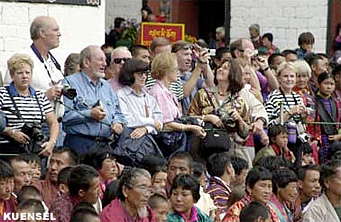 |
Hotel
Druk in Thimphu had about 47 percent occupancy in 2006. In the last two
years, it saw only one or two percent increase in the number of tourists
putting up in their hotel.
"Although
the number of tourists is increasing every year, they get consumed by the
many new hotels coming up and offering slightly lower rates and introducing
new products," said the hotel's senior manager, Dilu Giri. |
|
| Contributed
by Samten Wangchuk, KUENSEL, Bhutan's national newspaper, 2007 |
 |
|







